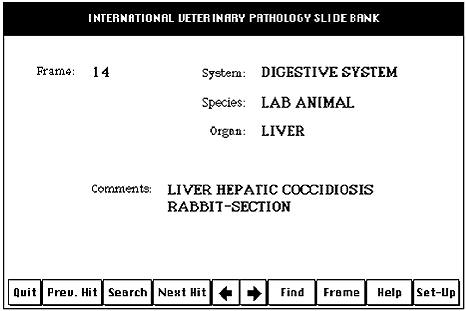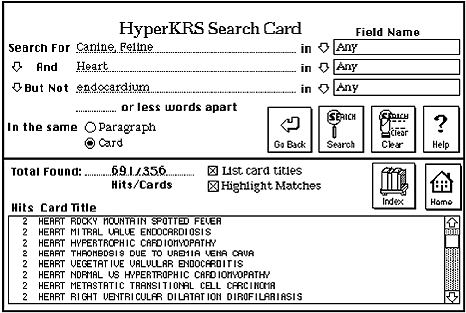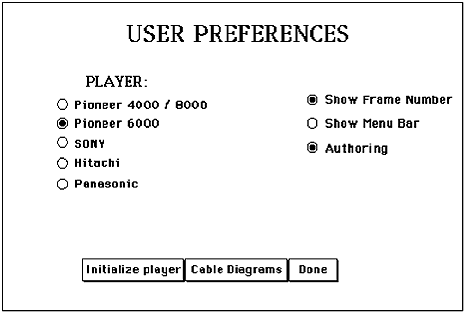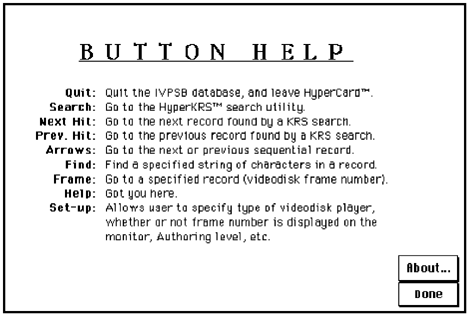JVME v20n3: Macintosh Database for the 5th Edition 'International Veterinary Pathology Slide Bank' Videodisc
| Volume 20, Number 3 | 1993 |
|---|
Macintosh Database for the 5th Edition
International Veterinary Pathology Slide Bank
Videodisc
B. R. Weeks, S. M. Hall, and R. Smith III
From the Department of Veterinary Pathobiology
Texas A&M University (Weeks, Smith), College Station, TX 77843
and the U.S. Department of Agriculture /FSIS Western Laboratory (Hall), Alameda, CA.
Introduction
The International Veterinary Pathology Slide Bank (IVPSB), based at the University of Georgia's College of Veterinary Medicine, maintains an extensive collection of photographic transparencies and motion picture footage pertaining to veterinary medicine. Thousands of photographs representing normal anatomy, gross and histologic lesions, electron microscopy, radiographs, and cytology preparations, as well as motion picture footage have been provided to the IVPSB by numerous worldwide contributors. The IVPSB regularly produces updated editions of a laser videodisc containing these images (1) . The videodisc's images are indexed by frame number in an accompanying catalog, (2) with descriptions of species, contributor's morphologic diagnosis, organs involved, etc. Images from the videodisc may be viewed one frame at a time, using a commercial videodisc player and video monitor. Copies of the videodisc's original photographic transparencies may also be ordered from the IVPSB.
The IVPSB videodisc is used by veterinary medical students, pathologists, and residents for reviewing gross pathology and histologic lesions. Additionally, numerous autotutorial lessons have been created which rely upon images from the IVPSB videodisc. Unfortunately, manually searching through the videodisc catalog for images of interest is tedious and inefficient, and requires repeated manual programming of the videodisc player in order to view selected images. An automated means of searching the videodisc catalog and displaying selected images is much preferred.
An available MS-DOS format database (2) for the IVPSB videodisc allows users of compatible computers to search the database, and display images of interest. Many other MS-DOS programs have been written for the IVPSB videodisc that allow automatic viewing of selected frames, either as fixed progressions through images sorted by diagnosis, species, or organ system, (3) or as interactive tutorial programs that display appropriate images from the videodisc when called for (4-6) .
The Department of Veterinary Pathobiology at Texas A&M University has an extensive Apple TM Macintosh computer network consisting of more than 50 workstations, linking faculty, staff, graduate students, and residents in pathology. We sought an efficient means of accessing the images and textual information of the IVPSB videodisc that was compatible with our existing Apple TM computer system. The database also had to be easily used by our faculty and students without extensive additional training.
Because there were no existing Macintosh TM compatible programs for the IVPSB videodisc, we originally constructed an electronic database of the first 7,318 images of the 4th edition IVPSB videodisc (7) . That database was created using HyperCard TM , a software package for Macintosh TM computers that allows simultaneous presentation of text, sound, digital images, etc. within a database featuring a graphical and relatively intuitive user interface. HyperCard TM is also readily adapted to automatically control most common brands of videodisc players. Software for using various HyperCard TM programs (HyperCard TM or HyperCard Player TM ) is provided with all Macintosh TM computers.
Materials and Methods
Data describing images of the IVPSB videodisc were exported as tab-delimited ASCII text from an existing MS-DOS d-Base format file, then imported into the HyperCard TM database. Each still image of the videodisc is represented by a sequential record ("card") in the HyperCard database; motion picture segments on the videodisc were not included in the database. Database programming and icons, screen labels, and data fields were configured with standard HyperCard TM programming and screen editing utilities (Appendix, Figure 1) . A Pioneer TM videodisc player (8) , connected via its standard serial communication port to an Apple© Macintosh computer is used to display each record's corresponding IVPSB image on a separate television monitor. Additional HyperCard TM programming to allow automatic control of videodisc players was installed using a resource editor (ResEdit TM , Apple Computer Corp.).
An additional indexed search utility (9) was incorporated into the database, which creates a archival index of each item in the database. This additional utility allows rapid and complex searches for numerous keywords within a large database. Additional "Search," "Next Hit," and "Prev. Hit" icons (Appendix, Figure 1) and HyperCard programming routines were added to allow browsing of only those images meeting indexed search criteria (Appendix, Figure 2) .
Searches for an individual, specific videodisc frame number are handled by a separate HyperCard TM program routine that allows rapid access to any videodisc frame. A simple "find" utility is also provided, allowing rapid location of any word or character string within the database, without resorting to the more elaborate indexed search. Upon access to any record within the IVPSB database, the videodisc player automatically displays the appropriate image (videodisc "frame").
Users may change the type of videodisc player addressed, using a "set-up" window within the program (Appendix, Figure 3) . Several common brands of videodisc players, including Pioneer TM (4000, 6000, and 8000-series), Hitachi TM , and Panasonic TM are supported.
Results
The HyperCard database for the IVPSB's 18,254 records occupies approximately 5.6 megabytes of disk storage space. The indexed search utility, which greatly improves the speed and versatility of searches within the IVPSB database, requires an additional 2.5 megabytes of disk space. Once installed on a Macintosh IIci with 8 megabytes of random-access memory (RAM), using HyperCard version 2.0 with 2 megabytes of RAM allocated for the application, the database takes approximately 70 seconds to initialize. After this initial wait, basic operations such as simple searches and sequential viewing of records generally require 1-2 seconds. Database performance for typical Macintosh computer configurations is compared in Table 1.
Table 1. Comparisons of performance* of the 5th edition International Veterinary Pathology Slide Bank videodisc database on various Macintosh TM computers.
Computer Time to Complete Operation (seconds)
Initialize Database Go to Next Record Indexed Search Macintosh Plus
130
2-5
20Macintosh IIsi
75
2-3
6Macintosh IIci
70
2
4* Comparisons were made using HyperCard TM version 2.0, with 2 megabytes random-access memory allocated to the application. All comparisons are based upon the number of seconds to complete the operation. The "Indexed Search" comparison is based upon the time required to compile a list of all records in the database containing the 3 terms bovine, heart, and lung.
The indexed search utility's "Search card" (Appendix, Figure 2) provides both pull-down menus and blank lines for entry of search criteria. The logical operators "and," "or," and "but not" are selected by clicking on appropriate icons. Multiple keywords may be entered as search criteria on a single line, separated by commas. Searches for partial words are accomplished by ending the search term with an asterisk. Using a Macintosh IIci computer, location of those 356 records in the database containing the keywords "canine" or "feline" and "heart", but not "endocardium" (Appendix, Figure 2) required 13 seconds. Once records meeting search criteria are located, moving between those selected records required 2 seconds.
Discussion
The IVPSB videodisc and its accompanying catalog offer a broad range of visual and textual data that are useful as teaching aids. With the database now available for Macintosh computers, residents, faculty and veterinary students at institutions using these computers will have ready access to thousands of high-quality photographic images related to veterinary pathology. The IVPSB videodisc and HyperCard TM database provides a convenient means of presenting photographs for review by veterinary students; pathology residents find the videodisc and database useful for specialty board preparation.
Modification of database programming and text within the database is readily accomplished without extensive reprogramming. Records and items within the database may be readily modified. However, to maintain integrity of the indexed search utility, database index files should be reconstructed, using HyperKRS utilities, after any modification of database content.
Our original HyperCard TM database for the 4th edition of the IVPSB featured several accessory functions, such as context-sensitive help, an on-line glossary of pathology terms, and a timed quiz function (6) . Comments from users of the original database indicated those functions contributed little to the program's overall effectiveness. In our experience, the IVPSB database is often used by groups of residents, and active discussion of images is preferred over timed progression through sets of images. Context-sensitive help was discontinued because users quickly became familiar with database functions, and required no further instruction. A single abbreviated "Help" window is now provided, which explains major database functions (Appendix, Figure 4) . The glossary function was eliminated in order to reduce disk storage requirements of the much larger 5th edition database.
In addition to providing a source of reference images for diagnostic and resident training purposes, the HyperCard TM IVPSB database provides faculty with a convenient means of locating appropriate images for use in creating interactive, computer-based tutorials. We use this database to locate images from the IVPSB when developing interactive tutorials in veterinary pathology (10, 11) . A HyperCard format database for the IVPSB allows Macintosh computer users convenient access to images of interest, with pertinent case data readily available.
Persons interested in this Macintosh-compatible database for the IVPSB 5th edition videodisc should contact the authors. The database will be made available without the "indexed search" features provided by HyperKRS®. If those additional features are needed, HyperKRS® (9) may be readily purchased and installed by the user.
Summary
The fifth edition of the International Veterinary Pathology Slide Bank videodisc contains more than 18,000 color photographic still images of interest to veterinary pathologists, as well as motion picture footage, diagrams, and radiographs. A textual database is provided for MS-DOS format computers that allows searches for specific keywords with automated display of videodisc images. Unfortunately, no similar means of searching the database has been readily available for Apple Macintosh TM computers. In order to provide users of Macintosh computers with convenient access to the case information and images of the videodisc, we created a database for these computers that allows rapid searches for cases of interest. The automated database we describe provides the user with pertinent case information and displays the specified videodisc image on a second video monitor. The database features an icon-based graphical interface, indexed search capability, and on-line help and setup utilities.
References and Endnotes
1. The International Veterinary Pathology Slide Bank and IVPSB Videodisc projects are coordinated by Wayne A. Crowell, DVM, PhD and D.E. Tyler, DVM, PhD; Department of Veterinary Pathology, College of Veterinary Medicine, University of Georgia, Athens GA 30602.
2. Smith F: VP-Find software. College of Veterinary Medicine, University of Georgia, Athens, GA 30602.
3. Hall SM: Systemic Pathology Study Sets for the IVPSB videodisc. Department of Veterinary Pathology, College of Veterinary Medicine, Manhattan, KS 66506.
4. Smith F: LIHM (Latent Image Hypermedia) software. College of Veterinary Medicine, University of Georgia, Athens, GA 30602.
5. Roesel, F: Vagus Authoring System. College of Veterinary Medicine, Purdue University, West LaFayette, IN.
6. Kazacos EA, Roesel OF, Harrington DD: Use of interactive videodisc programs in teaching pathology. Proceedings of the 12th Veterinary Medical Education Symposium , Ames IA. p. 22, 1992.
7. Weeks BR, Smith, R. III, Snell JR. Hall SM: A hypertext database for accessing the International Veterinary Pathology Slide Bank videodisk. In Proceedings of the 14th Annual Symposium on Computer Applications in Medical Care , Miller RA (Ed.) , pp. 922 - 926. IEEE Computer Society Press, Los Alamitos, CA, 1990.
8. Pioneer TM Model 6010 videodisc player, Pioneer TM Electronics Corp., Long Beach, CA 90801-1720.
9. HyperKRS TM indexed search utility, KnowledgeSet Corp. Mountain View, CA 94041
10. Weeks BR, Smith R III, Adams LG, Read WK: Computer-aided instruction in veterinary pathology at Texas A&M University." J Am Vet Med Assoc 196:1413, 1990.
11. Weeks BR, Smith R III: Instruction in veterinary pathology using HyperCard TM and Apple Macintosh Computers. Proc Am Coll Vet Pathol 41:159, 1990.
APPENDIX (Figures 1-4)
Figure 1. A typical IVPSB 5th edition HyperCard TM database record. The corresponding videodisc frame number is displayed in the upper portion of the screen. Data concerning the organ system(s) and species, as well as contributor comments and diagnosis, are provided in the lower portion of the screen. Most database functions are controlled by "clicking" on the appropriate button icons, arranged along the lower margin of the screen.

Figure 2. The HyperKRS TM search utility, which allows complex searches using numerous keywords. In this example, 356 records were found matching the search criteria of "canine or feline"; and "heart"; but not "endocardium." Records meeting the search criteria are listed near the bottom of the screen; highlighting one of these choices opens that record, and displays the corresponding video image on a second monitor.

Figure 3. The set-up utility screen. Users may select from several types of videodisc player, and enable display of the videodisc's frame number on the second monitor. The "authoring" option allows program modifications and alterations of records.

Figure 4. Information about the various functions is available to users by clicking the "Help" icon. A brief explanation of each button's major function is provided.

